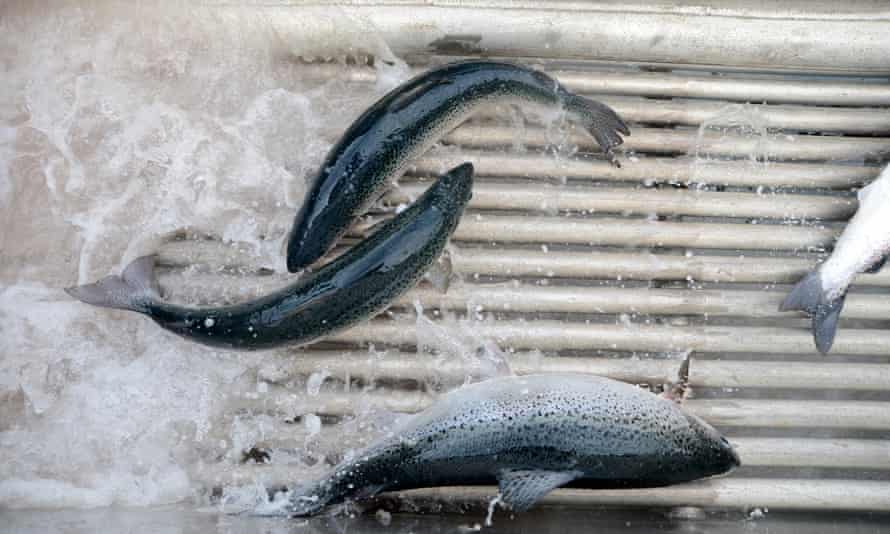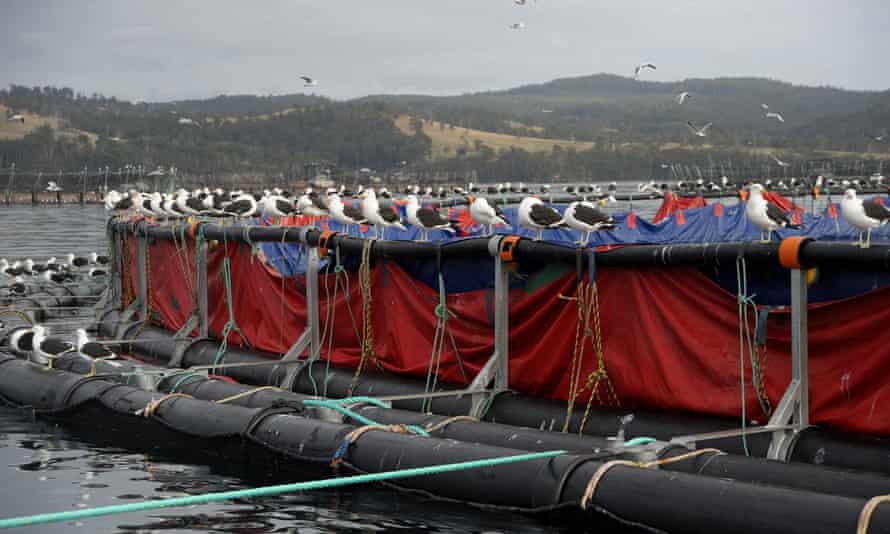Landing salmon: can Tasmania clean up the industry by bringing it onshore?
Amid growing concern about the environmental impact of farming salmon in pens exposed to the sea, something novel is being proposed

Last modified on Sat 4 Sep 2021 22.55 EDT
During the summer when the weather is good, Mark Bishop’s fishmonger is open one hour a day during the week and throughout the afternoon on Saturdays.
The 56-year-old former furniture manufacturer opened the tiny shop in Stanley, on Tasmania’s north-west coast, with his son, a local fisher, to sell their catch direct to the public.
“We only sell wild-caught,” Bishop says with emphasis. “Sustainable, wild-caught. You can go to Woolies or the IGA for the other stuff.”
What Bishop calls “the other stuff” has become something of a dirty word in the town of 553 people ever since the salmon farming industry announced plans to move into Bass Strait as part of a statewide expansion.
“It’s interstate tourists that ask for it,” Bishop says. “They purchase it in their own local area and it’s labelled as Tassie salmon, so they think it’s from Tasmania. They don’t understand it’s a battery hen-type product.
“It makes you feel pissed off because that particular industry is trading on Tasmania’s clean, green image. And their practices of growing their salmon certainly don’t equate to anything clean, green or sustainable, in my view.”
Atlantic salmon – the main variety bred in Tasmania – are certainly not native to Tasmania. The species’ traditional range stretches from the frigid waters of northern Europe through to the north-east coast of the US.
The practice of farming the fish in enclosed mesh pens exposed to the sea was introduced to Australia in 1986. What began with a small number of boutique operations has evolved into a massive industrial operation worth $887m in 2020, generating 65,800 tonnes of protein a year.
Now, the state government’s “vision” is for a huge expansion of the industry that would more than double its value over the next decade.
But with growing concern about the environmental impact of the salmon industry, critics and analysts alike are proposing something novel: bring it onshore.
Moving fish farming into industrial operations on land is not without its drawbacks, but those fighting a fierce campaign against the industry’s expansion say it’s the only way to solve its inherent problems. The industry, however, fears any such move would close the Tasmanian salmon industry for good.
‘The wrong fish in the wrong place’
To date the Tasmanian government has treated the state’s salmon-farming industry as a potential goldmine which, under its sustainable industry growth plan, it hopes will be worth $2bn by 2030.

The three major operators – Huon, Tassal and Petuna – have planned vast expansions in areas such as Storm Bay, south of Hobart, and the Bass Strait.
The primary industries minister, Guy Barnett, says the “strong interest” from international investors thanks to “Tasmania’s natural and competitive advantages” can mean only good things.
“The Tasmanian salmon industry has a bright future and it will continue to play a key role in delivering sustainably produced quality food while employing thousands of Tasmanians,” Barnett says.
But opponents such as Jilly Middleton from Environment Tasmania say the island’s sheltered river estuaries and bays do not have the capacity to sustain that level of production.
“The idea that the industry is going to double in value and increase their size, it’s just mind-boggling,” Middleton says. “It’s the wrong fish, in the wrong place.”
Bishop, who is also co-chair of the Tasmanian Alliance for Marine Protection, says the unique geology of the Bass Strait means problems with pollution will inevitably damage marine life and put pressure on stocks of wild fish.
“The salmon farmers say, ‘Don’t worry! There’s nothing to worry about,'” Bishop says. “That’s their mentality because if it does go wrong and if they have a catastrophic problem with their salmon, they go back to the hatchery and start again.
“But who’s going to restock the wild fish? You can’t.”
Critics of the industry point to the plastic pollution created when pens break apart during rough weather; the risk to native marine life whose life cycles are tied to sensitive river estuaries; animal welfare concerns for the fish and inquisitive seals that try to feed on them; even the legal arrangements that allow once-public areas to be penned in for salmon farming.
By far the most contentious issue is the concentrated effluent released by huge schools of fish corralled into pens.
As this untreated waste builds up beneath and around the pens it raises nitrogen levels, triggering toxic algal blooms and driving out native marine life.
The author Richard Flanagan, whose recent book Toxic takes aim at the industry, says this feature alone means its future is untenable.
“A sea-based salmon farm is a floating sewage farm – except the sewage is left to pour raw and untreated into our oceans,” Flanagan says.
Tassal did not respond to requests for comment while Petuna directed questions to the industry body, the Tasmanian Salmonid Growers Association, whose head, Julian Amos, says such claims are “nonsense”.
Amos says the industry “practises continuous improvement in its approach to farm management” which “has enabled the development of more robust pen and lease infrastructure”.
“It also practises adaptive management practices, which in effect means that it can adapt to changing circumstances, such as water temperature and oxygen levels,” Amos says. “It monitors pens on a 24/7 basis for fish health and water quality, and environmental monitoring is also undertaken by independent, third-party scientists and researchers.”
A spokesperson for Huon said the company had no plans to expand its farming footprint and had been the first in the industry to embrace new technologies, move its pens into offshore waters and “land-based facilities”.
“We know we are stewards of the waterways we farm, so they can be enjoyed and farmed for generations to come,” they said.
Yet the industry has had a rocky history. The first time the environmental impact became widely known was in 2018, with the death of 1.35m salmon and trout being farmed in Macquarie Harbour on the west coast. .
Fish farming largely relies on natural currents and tidal flows to flush the effluent from its pens, but the geography of Macquarie Harbour meant this did not happen. As the effluent leached oxygen from the water, a layer of de-oxygenated water was allowed to build up until it suffocated the fish.
In the aftermath, World Wildlife Fund Australia chose to end its six-year relationship with Tassal, but the incident looms large in the public imagination and continues to generate controversy. On Wednesday WWFA released an independent report it commissioned that found its certification system failed to prevent “adverse ecological outcomes”.
‘An argument for closure of the industry’
Flanagan says moving the industry onshore is not perfect, but is the only way to fix it.
“No other solution ends the catastrophic destruction to marine ecosystems or the systematic animal cruelty implicit in sea-based salmon farming,” Flanagan says.
Farming fish on land mostly involves large-scale industrial set-ups known as circulating aquaculture systems (RAS). Salmon are reared in large tanks where water is continuously purified and a strong current is generated to mimic the effect in their natural environment.

Every variable is controlled: temperature, salinity and pH of the water, its oxygen content, lighting cycle and the removal of waste such as CO2 or effluent. As the waste is filtered out, the water is treated, processed and reused.
Perhaps the most well-known RAS operation is Atlantic Sapphire’s ambitious Bluehouse project in south Florida. The company’s manager director, Karl Oystein Oyehaug, says the operation can farm 900 tonnes of salmon on roughly half a hectare of land – and does so cleanly.
“By containing the salmon within our Bluehouses, Atlantic Sapphire eliminates the threats to wild fish stock and our own fish from sea lice, parasites and other diseases being transferred,” Oyehaug says. “We [also] avoid untreated fish waste being emitted into coastal areas, and we ensure that no microplastics and other contaminants are ingested by the fish.”
Crucially, none of the solid waste is discharged into the ocean. At Atlantic Sapphire’s Danish operation any solid waste is separated and reused to create biogas, while in Florida the material is processed and then composted or disposed offsite at a solid waste facility.
The company plans to expand production at its Miami site to produce more than 180,000 tonnes of salmon by 2031 – though there have been complications. While it did not provide exact numbers, in March this year the company reported that a design bug killed 5% of its annual harvest.
Amos says calls for the industry to head onshore are “an argument for closure of the industry”.
“There is some activity in this space occurring overseas, much of it still experimental, and we are watching those developments closely,'” Amos says.
Amos, a former state Labor politician, says that because the technology is so new, a greenfields development cannot exist in Tasmania under current regulatory frameworks.
But Oyehaug says local authorities in Florida were quick to embrace the concept.
“They recognised we bring a new ultra-sustainable industry and will create thousands of jobs.”
‘Disruptive technology’
In 2019, the Dutch agricultural investment bank Rabobank described RAS as a “disruptive technology” that may provide a way to fill a global structural demand for salmon protein.
With 50 new projects proposed worldwide, Rabobank’s global seafood manager, Gorjan Nikolik, says the total planned production from RAS-farmed salmon is in the region of 2m metric tonnes – but most are hamstrung by finance.
“Only very few companies have financing to start production and even these need to raise much more capital to expand beyond the pilot phase,” Nikolik says. “In our view, for the foreseeable future RAS will be viable as a high-value niche product and mostly successful in regions which are far from the existing coastal producers.”
Tasmania’s salmon farmers have taken their own hit through the pandemic. Last week Huon Aquaculture – which is for sale and subject to a fight between mining billionaire Andrew Forrest and the meat processing giant JBS – announced a $128m loss, despite a 39% increase in production.
Speaking to investors, Huon chief executive Peter Bender put the loss down to a global oversupply of salmon, plunging prices and the cost of freight in the wake of snap border closures, but said he expected improvement by 2023.
“The outlook for the salmon market is much brighter than it was this time last year, however there is a general agreement that recovery will take some time,” Bender said.
Economics aside, the final challenge for the industry is the long term-effect of climate change. With the world’s oceans absorbing 90% of the heat trapped by carbon emissions, critics such as Middleton point to Tasmania’s warming waters and say the industry is on borrowed time.
Marine heatwaves have already killed stocks of farmed fish. Though the industry is taking steps to counteract warming, Middleton says it can only defy gravity for so long.
“The right future for the industry is for them to make a swift transition to on-land production,” she says. “That would be the industry-leading way to go.”